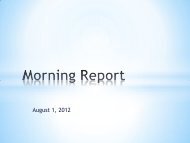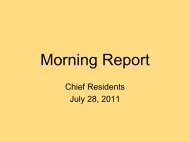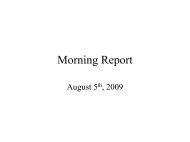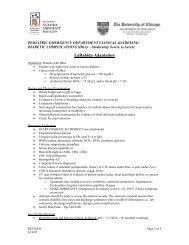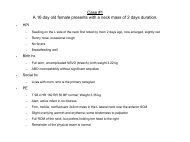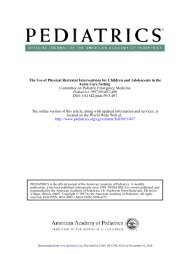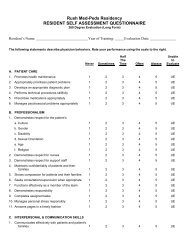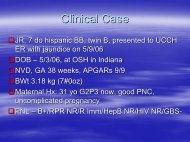Carbon Monoxide Poisoning
Carbon Monoxide Poisoning
Carbon Monoxide Poisoning
Create successful ePaper yourself
Turn your PDF publications into a flip-book with our unique Google optimized e-Paper software.
<strong>Carbon</strong> <strong>Monoxide</strong><br />
<strong>Poisoning</strong><br />
Morning Report<br />
January 7, 2009
Sources of <strong>Carbon</strong> <strong>Monoxide</strong><br />
Car exhaust fumes (#1 cause of CO-related death)<br />
Smoke from fires (#2)<br />
Furnaces<br />
Gas-powered engines (idling boats)<br />
Home water heaters<br />
Wood stoves/ gas stoves/ space heaters<br />
Paint removers (containing methylene chloride)<br />
Tobacco smoke<br />
Pool heaters
Pathophysiology<br />
Curve shifts LEFT<br />
O2 delivery to tissues<br />
…Tissue hypoxia ensues
Historical Clues<br />
Co-inhabitants with similar symptoms at same onset<br />
Symptoms recur and do not follow a regular 7-10<br />
day viral course<br />
Alternative heating devices (space heaters, gas<br />
stoves), wintertime (idling auto with snow blocked<br />
exhaust pipe)<br />
Improves when away from site<br />
Absence of sore throat/fever/URI symptoms<br />
Illness or death of a family pet
Environmental Exposure History<br />
Community (urban vs.rural/near industrial sites)<br />
Home (heating sources, location of bedrooms,<br />
fireplaces, wood stoves)<br />
Hobbies (especially hockey, ice skating)<br />
Occupation (industrial sites w/ inadequate<br />
ventilation, auto repair shops, loading docks)<br />
Personal (screen for depression/suicidal ideation)<br />
Diet<br />
Drugs (especially tobacco)
Clinical Presentation<br />
COHb 20%<br />
Headache<br />
Dizziness<br />
Weakness/myalgia<br />
Nausea/vomiting<br />
Shortness of breath<br />
Visual changes<br />
Chest pain<br />
COHb >40%<br />
Confusion<br />
Syncope<br />
Pulmonary edema<br />
Coma<br />
Seizures<br />
COHb >60%<br />
Cardiac ischemia<br />
Death<br />
Classic Triad “cherry red lips,<br />
cyanosis & retinal hemorrhages”<br />
Delayed Neuropsychiatric Syndrome<br />
Delayed onset of neurologic symptoms after apparent<br />
recovery from acute CO intoxication<br />
Occurs 3-240 days (mean 20) in up to 50% of patients<br />
The development of DNS correlates poorly with COHb levels<br />
Symptoms: cognitive and personality changes, parkinsonism,<br />
dementia, psychosis, movement disorders<br />
Imaging will often show abnormalities within the globus<br />
pallidus and the deep white matter<br />
Recovery occurs in 50-75% of affected persons within one<br />
year
Diagnosis<br />
Carboxyhemoglobin level<br />
Measured directly via co-oximetry<br />
A low level does not rule out acute intoxication<br />
ABG- metabolic acidosis (and co-oximetry)<br />
PaO2 may be normal!<br />
BMP- anion gap metabolic acidosis<br />
EKG
Management<br />
100% O2<br />
Half-life of COHb :<br />
Room air: 4-5 hrs<br />
100% oxygen: 90 min<br />
Hyperbaric oxygen: 20-30 min<br />
Ventilatory support if needed<br />
Cardiac monitoring<br />
Most CO poisonings can be managed in the ED<br />
COHb levels >25% admission is recommended
Hyperbaric Oxygen Therapy<br />
HBO involves exposure to 100% FiO2 under supraatmospheric<br />
conditions (2.5-3.0 atm)<br />
May be beneficial in preventing the late<br />
neurocognitive deficits (DNS)<br />
Results of clinical trials vary widely<br />
Most authorities recommend HBO if:<br />
COHb >30%<br />
LOC, acute neurological deficits<br />
Pregnant women with COHb >15%
Take Home<br />
CO poisoning results in nonspecific sx…HA,<br />
dizziness, weakness, N/V<br />
SaO2 and PaO2 may be normal…
References<br />
Abelsohn, A, Sanborn MD., Jessiman, BJ. Identifying and managing<br />
adverse environmental health effects: <strong>Carbon</strong> monoxide poisoning.<br />
CMAj. 2002; 166 (13): 1685-1690<br />
Armin Ernst, MD and Joseph D. Zibrak, MD. <strong>Carbon</strong> <strong>Monoxide</strong><br />
<strong>Poisoning</strong>. NEJM 1998; 339:1603-1608.<br />
Juurlink DN, Stanbrook MB, McGuigan MA. Hyperbaric oxygen for<br />
carbon monoxide poisoning. Cochrane Database Syst Rev 2005; 1:<br />
CD002041<br />
Weaver LK, et al. Hyperbaric oxygen for acute carbon monoxide<br />
poisoning. NEJM 2002; 347: 3. Reviewed in: The Peds CCM Evidence-<br />
Based Journal Club, 2003.



